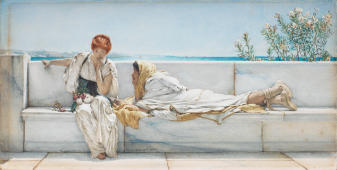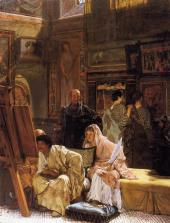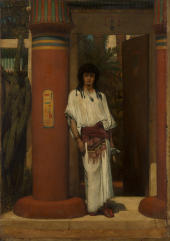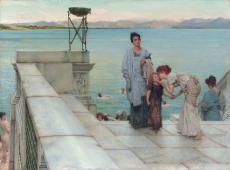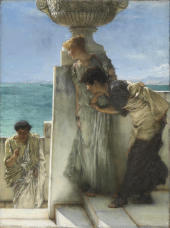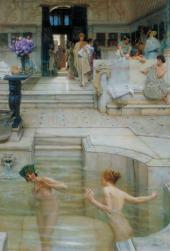Lawrence Alma Tadema Oil Painting Reproductions
Lawrence Alma Tadema replica paintings on Canvas for sale
Explore Victorian Paintings by Lawrence Alma Tadema
Lawrence Alma Tadema gained fame for creating his famous Victorian paintings of ancient civilizations. Although known for Victorian oil paintings, his art goes beyond capturing the spirit of that era.
Romanticism paintings by Alma Tadema often depict scenes from ancient Rome, Greece, and Egypt, showcasing the opulence and grandeur of these ancient civilizations. His famous paintings characterize meticulous attention to detail, vibrant colors, and realistic portrayal of architecture, costumes, and everyday life.
Alma Tadema paintings are often referred to as Academic art and are influenced by the classical art of the past. He meticulously researched historical details, using them to create accurate and visually stunning compositions. His paintings often feature mythological or historical narratives, bringing these ancient stories to life on canvas.
Lawrence Alma-Tadema Early Life and Influences
Lawrence Alma-Tadema is a renowned Dutch-British painter known for his stunning oil paintings. Here, we explore his life and influences, including his childhood in the Netherlands, the influence of Dutch Golden Age paintings on his early work, and his introduction to classical mythology and history.
Alma Tadema was born in the town of Waadhoeke in 1836. He grew up in a family of artists, greatly influencing his passion for painting. His father was a notary and amateur artist, and his mother was an accomplished amateur painter. Alma Tadema's early exposure to art and the creative atmosphere at home significantly shaped his future career as a famous artist.
Alma Tadema received his first formal art education at the Academy of Fine Arts in Antwerp, Belgium, where he studied under the guidance of the renowned painter Gustave Wappers. This training gave him a solid foundation in the technical aspects of painting and helped him develop his unique style.
Alma Tadema's upbringing exposed him to the rich artistic tradition of Dutch Golden Age paintings. The art of Rembrandt and paintings by Vermeer, known for their realism and detail, particularly inspired him. Alma Tadema's early works often feature meticulous detail, capturing natural light and textures.
Lawrence Alma Tadema's childhood in the Netherlands and the artistic influences he encountered during that time played a crucial role in shaping his future as a famous artist.
Famous Paintings by Lawrence Alma Tadema
1. The Roses of Heliogabalus
The Roses of Heliogabalus is one of Lawrence Alma-Tadema's most famous paintings. It depicts a scene from the life of the Roman emperor Heliogabalus, also known as Elagabalus. The painting shows Heliogabalus suffocating his guests with rose petals during a lavish banquet.
The painting is based on a historical event. According to accounts, Heliogabalus often held extravagant feasts where he would shower his guests with rose petals until they were buried alive. This act symbolizes his power and extravagance.
In this oil painting, Alma Tadema captures the opulence and decadence of the Roman Empire. The painting is meticulously detailed, showcasing the luxurious surroundings and the guests' expressions of shock and horror. The use of light and color adds to the scene's dramatic effect.
Symbolism and themes explored in The Roses of Heliogabalus include the excesses of power, the transitory nature of life, and the contrast between beauty and cruelty. Alma Tadema’s painting serves as a commentary on the decadence and moral corruption of the Roman Empire.
The Roses of Heliogabalus is a striking example of Lawrence Alma-Tadema's ability to bring ancient Roman history to life through his art.
2. The Finding of Moses
The Finding of Moses is one of Lawrence Alma-Tadema's most famous Religious paintings. Tadema's Mary Magdalene painting of 1854 is a beautiful portrait of the disciple of Jesus.
Lawrence Alma Tadema’s oil painting depicts the biblical story of Moses being found by Pharaoh's daughter in the river Nile. His attention to historical accuracy is evident in the intricate details of the painting.
The composition of The Finding of Moses includes several symbolic elements. For example, the central focus of the painting is on the figure of Pharaoh's daughter, who is portrayed as a compassionate and caring woman. This symbolizes the idea of mercy and the preservation of life.
Lawrence Alma Tadema's meticulous attention to detail is evident in the depiction of Egyptian architecture, clothing, and other elements of daily life. This attention to detail helps to recreate the atmosphere and essence of ancient Egypt.
The Finding of Moses is a masterpiece religious painting showcasing Lawrence Alma-Tadema's skill in accurately depicting historical scenes and capturing the beauty and grandeur of ancient civilizations.
3. A Coign of Vantage.
Lawrence Alma Tadema's painting A Coign of Vantage is a beautiful painting displaying meticulous detail and historical accuracy. The painting depicts a Roman courtyard scene, with two women looking out from a balcony or "coign of vantage."
The composition of the oil painting is carefully crafted, using light, color, and perspective to create a sense of depth and realism. Alma Tadema's skillful use of light and shadow adds to the overall atmosphere of the scene, while the vibrant colors bring the painting to life.
One of the remarkable aspects behind the painting A Coign of Vantage is the artist's extensive research on ancient Roman culture. This is evident in the detailed depiction of the painting's architecture, clothing, and overall setting.
A Coign of Vantage is a superb example of Alma Tadema's painting style and ability to create visually stunning and historically accurate oil paintings.
Sir Lawrence Alma-Tadema’s Impact on the Art World
Lawrence Alma Tadema paintings significantly impacted the art world during his lifetime and continue to this day.
During his career, Tadema achieved great recognition and success. He was highly sought after by collectors and patrons, and his oil paintings were in high demand. His attention to detail, technical skill, and ability to create realistic and immersive scenes set him apart from other artists of his time.
Tadema's influence on subsequent generations of artists cannot be overstated. His innovative approach to historical and mythological subjects inspired many artists to follow in his footsteps. His techniques and style were adopted by the paintings of the Pre Raphaelite Brotherhood, a group of English painters who sought to revive the detailed and vibrant style of early Renaissance art.
Alma Tadema paintings are exhibited in major museums around the world. His artwork can be found in renowned institutions such as the Metropolitan Museum of Art in New York, the Louvre in Paris, and the Victoria and Albert Museum in London. These exhibitions allow art enthusiasts to appreciate and study Tadema's work, ensuring that his legacy continues to be celebrated.
Lawrence Alma Tadema's impact on the art world is undeniable. His skill, innovation, and attention to detail have inspired generations of artists, and his works continue to be admired in museums worldwide.
Reproduction oil paintings have become increasingly popular among art enthusiasts and collectors. Our exquisite replica paintings allow individuals to own a piece of history and experience the beauty of renowned artists such as Lawrence Alma Tadema, William Adolphe Bouguereau, and Frederic Leighton.
Buy fine art reproductions of these three influential artists. From their unique styles to the significance of their paintings, enjoy owning a hand-painted oil on canvas oil painting that captures the essence of these famous paintings.
Cannot Find What You Are Looking For?
Reproduction Gallery Information
Customer Service
(Send Us A Message)
Tel: (503) 937 2010
Fax: (503) 937 2011


